
Concept explainers
(a)
Accounting for Receivables:
Receivables are defined as the amounts that are due to a firm by its customers and other parties. Receivables include all those assets that arise due to the primary operations of a firm and those representing cash that is to be collected from all external parties who owe money to the firm.
Receivables are broadly categorized into trade-receivables and non-trade receivables. Trade receivables refer to those receivables that occur due to the sale of goods and services in the normal course of business. Non-trade receivables refer to the amounts that occur due to third parties from transactions outside the primary course of business.
Notes receivable:
Notes receivable can be defined as a written promissory note. It can also be referred to as a note required for collection of interest and is collected within a time period of 60 to 90 days. It is a result of sales transactions.
Promissory note gives the holder a stronger legal claim as compared to accounts receivable. It can easily be sold to another party and can be transferred to another party through endorsement, since they are negotiable instruments. A promissory note holder is also liable to earn interest.
To journalize: The transactions for E. Company.
(b)
To record: The collection of L’s note at its maturity in 2018.
Want to see the full answer?
Check out a sample textbook solution
Chapter 9 Solutions
Accounting Principles 12th Edition
- During June, the production department of a process operations system completed and transferred to finished goods a total of 82,000 units of product. At the end of May, 18,000 additional units were in process in the production department and were 70% complete with respect to materials. The beginning inventory included a materials cost of $92,400 and the production department incurred a direct materials cost of $276,800 during June. Compute the direct materials cost per equivalent unit for the department using the weighted-average method.arrow_forwardCan you solve this general accounting question with the appropriate accounting analysis techniques?arrow_forwardDuring the month of April, Nikko Corporation used $28,500 of direct materials and incurred $39,700 of direct labor costs. Manufacturing overhead applied to products amounted to $19,200. If the cost of goods manufactured was $125,000 and the ending work in process balance was $18,900, the beginning work in process must have been equal to _.arrow_forward
- Hello tutor please given General accounting question answer do fast and properly explain all answerarrow_forwardI need assistance with this financial accounting problem using valid financial procedures.arrow_forwardCan you solve this financial accounting question using valid financial methods?arrow_forward
- I am searching for the accurate solution to this general accounting problem with the right approach.arrow_forwardWhat is the amount of fixed manufacturing overhead absorption costing?arrow_forwardAt the beginning of the year, manufacturing overhead for the year was estimated to be $318,500. At the end of the year, the actual direct labor hours for the year were 32,700 hours, the actual manufacturing overhead for the year was $315,200, and the manufacturing overhead for the year was overapplied by $17,300. If the predetermined overhead rate is based on direct labor hours, then the estimated direct labor hours at the beginning of the year used in the predetermined overhead rate must have been___.arrow_forward

 AccountingAccountingISBN:9781337272094Author:WARREN, Carl S., Reeve, James M., Duchac, Jonathan E.Publisher:Cengage Learning,
AccountingAccountingISBN:9781337272094Author:WARREN, Carl S., Reeve, James M., Duchac, Jonathan E.Publisher:Cengage Learning, Accounting Information SystemsAccountingISBN:9781337619202Author:Hall, James A.Publisher:Cengage Learning,
Accounting Information SystemsAccountingISBN:9781337619202Author:Hall, James A.Publisher:Cengage Learning, Horngren's Cost Accounting: A Managerial Emphasis...AccountingISBN:9780134475585Author:Srikant M. Datar, Madhav V. RajanPublisher:PEARSON
Horngren's Cost Accounting: A Managerial Emphasis...AccountingISBN:9780134475585Author:Srikant M. Datar, Madhav V. RajanPublisher:PEARSON Intermediate AccountingAccountingISBN:9781259722660Author:J. David Spiceland, Mark W. Nelson, Wayne M ThomasPublisher:McGraw-Hill Education
Intermediate AccountingAccountingISBN:9781259722660Author:J. David Spiceland, Mark W. Nelson, Wayne M ThomasPublisher:McGraw-Hill Education Financial and Managerial AccountingAccountingISBN:9781259726705Author:John J Wild, Ken W. Shaw, Barbara Chiappetta Fundamental Accounting PrinciplesPublisher:McGraw-Hill Education
Financial and Managerial AccountingAccountingISBN:9781259726705Author:John J Wild, Ken W. Shaw, Barbara Chiappetta Fundamental Accounting PrinciplesPublisher:McGraw-Hill Education





